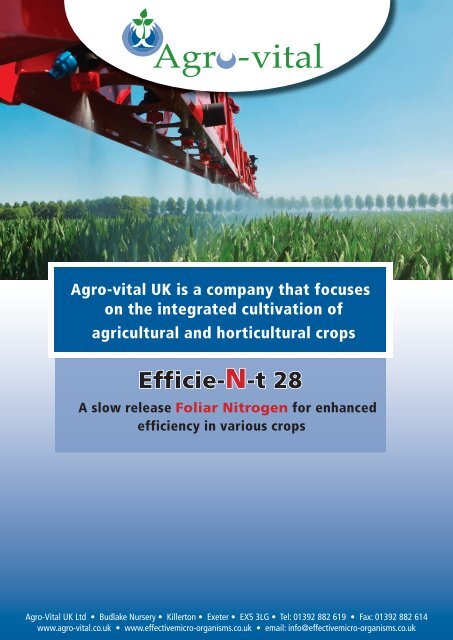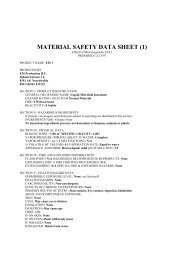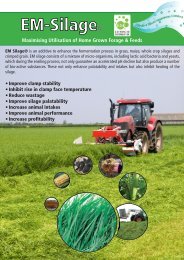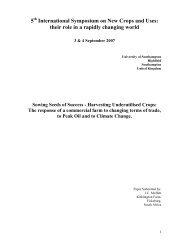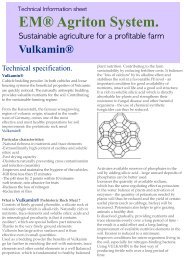Efficient 28 brochure - Effective Micro-organisms
Efficient 28 brochure - Effective Micro-organisms
Efficient 28 brochure - Effective Micro-organisms
Create successful ePaper yourself
Turn your PDF publications into a flip-book with our unique Google optimized e-Paper software.
Agro-vital UK is a company that focuses<br />
on the integrated cultivation of<br />
agricultural and horticultural crops<br />
Efficie-N-t <strong>28</strong><br />
A slow release Foliar Nitrogen for enhanced<br />
efficiency in various crops<br />
Agro-Vital UK Ltd • Budlake Nursery • Killerton • Exeter • EX5 3LG • Tel: 01392 882 619 • Fax: 01392 882 614<br />
www.agro-vital.co.uk • www.effectivemicro-<strong>organisms</strong>.co.uk • email: info@effectivemicro-<strong>organisms</strong>.co.uk
What is Efficie-N-t <strong>28</strong><br />
It is a liquid foliar nitrogen fertiliser based on urea polymers of variable<br />
lengths. The longer the chains, the slower they breakdown, resulting in a<br />
phased release of nitrogen over a total of 6 to 8 weeks.<br />
The polymer chains break down to release nitrogen as amide(NH2), groups which<br />
are the building blocks of proteins, a process that is much more energy efficient than<br />
converting nitrate(NO3) groups into protein.<br />
Efficie-N-t <strong>28</strong>‘s novel chemistry delays the nitrogen availability to the crop to<br />
give a natural physiological response, avoiding the ‘flush’ growth, seen with nitrate<br />
based fertilisers. Nitrates draw in water, weakening the cell walls, making the crop<br />
more prone to lodging and attack by diseases.<br />
Environmental Benefits<br />
• Not prone to leaching<br />
• Not prone to volatilisation<br />
• Nearly 100% uptake<br />
• Accurate application<br />
• Helps stay within N max<br />
• Minimises environmental impact<br />
Agronomic Benefits of Efficie-N-t <strong>28</strong><br />
• Reduction in nutrient losses that occur between application<br />
and uptake by the crop<br />
• Reduced chance of scorch<br />
• Phased release over 6 to 8 weeks<br />
• Optimises nitrogen efficiency<br />
• Improved yields and improved quality<br />
• “Sticky” technology and miscible with fungicides<br />
Growing Oil Seed Rape<br />
with Efficie-N-t <strong>28</strong><br />
Canopy management in oil seed rape<br />
aims to achieve optimum canopy size,<br />
to intercept the maximum amount of<br />
sunlight, through the rate and timing of<br />
nitrogen fertiliser.<br />
Foliar nitrogen applied around the end of<br />
flowering in oil seed rape has been shown<br />
to increase yield over and above what can<br />
be achieved from optimal applications of soil applied nitrogen.<br />
Efficie-N-t <strong>28</strong> can be used pre and post flowering to ensure N nutrient supply to maintain<br />
canopy green area and to boost pod fill.<br />
AGRO VITAL - ‘SMART’ FERTILISERS OF THE FUTURE
t/ha 12% 13% 14% 15%<br />
6 115 125 135 145<br />
development of these yield components can be<br />
managed to a certain extent.<br />
7 135 145 155 165<br />
8 155 165 180 190<br />
9 175 185 200 215<br />
10 195 210 225 240<br />
Table J : Nitrogen removal by cereal grain<br />
with differing crude protein contents and<br />
yields, in kg N /ha.<br />
The grain yield of a cereal plant is determined<br />
by three factors:<br />
• the number of ear-bearing stalks,<br />
• the number of grains per ear, and<br />
• the average weight of the grains.<br />
During the development of the cereals, these<br />
three yield components effect each other, both<br />
positively and negatively. For example, a large<br />
number of ear-bearing shoots will result in a<br />
relatively low number of grains per ear and a<br />
lower grain weight. By adjustment of the<br />
100<br />
90<br />
80<br />
70<br />
60<br />
50<br />
40<br />
30<br />
20<br />
10<br />
0<br />
%<br />
number of<br />
ear-bearing shoots<br />
Number of ear-bearing shoots.<br />
Cereals are able to auto-regulate the number<br />
of ear-bearing shoots per plant during the<br />
tillering stage. The extent to which tillering<br />
takes place depends, among other things, on<br />
the nutrient supply, especially on the amount<br />
of nitrogen available to the individual plant.<br />
This gives the grower an excellent means of<br />
optimising the number of ears per unit area.<br />
When the nitrogen supply per plant is<br />
insufficient, e.g. due to a low fertilizer rate or a<br />
high seed rate, the individual plants produce<br />
only few ear-bearing shoots. Vice-versa,<br />
tillering is promoted by an ample nitrogen<br />
supply. Too high a rate, however, leads to<br />
excessively dense crop stands with high<br />
competition between the shoots which then<br />
produce fewer and smaller grains per ear. As a<br />
result, the yield per area is reduced and the risk<br />
of lodging after a thunderstorm or fungal<br />
infection is increased.<br />
nitrogen uptake<br />
number of grains per ear<br />
1 st application<br />
2 nd application<br />
grain weight<br />
3 rd application<br />
Figure 19 : Timing of nitrogen applications in relation to the development of nitrogen uptake and yield<br />
components of winter wheat. A large number of ear-bearing shoots and grains per ear are initiated and are<br />
later reduced in accordance with the growing conditions to sustainable numbers.<br />
Independent, fully replicated trials, have been<br />
conducted in winter wheat, over two seasons in<br />
the Netherlands.<br />
The control plots received a total of 209 kg<br />
Nitrogen / hectare, split into three applications, in<br />
the form of calcium ammonium nitrate (CAN).<br />
In the treatment plots 40kg of Nitrogen, from<br />
calcium ammonium nitrate at flag leaf was<br />
replaced with 7kg of Nitrogen from<br />
Efficie-N-t <strong>28</strong><br />
Matching Nutrient Supply Growth<br />
Maize Trials with Efficie-N-t <strong>28</strong><br />
51<br />
Maize needs some 50% of it’s total Nitrogen requirement from the 8<br />
leaf stage to tassling, with a further 35% needed for cob fill during<br />
August to September.<br />
Potential losses of seed bed applied<br />
nitrogen may leave the crop short of<br />
essential nitrogen during these later<br />
stages of growth.<br />
To address this issue field trials of<br />
25kg applications of <strong>Efficient</strong> <strong>28</strong> at the<br />
8 leaf stage were carried out at three<br />
sites in Cheshire, Somerset and Devon.<br />
RESULTS:<br />
RESULTS: showed an improvement in<br />
• Yield<br />
• Grain Quality<br />
• Protein<br />
• 1000 grain weight<br />
• Hagberg levels<br />
Treated plots yielded an additional 3.4, 4 & 5 tonnes per acre fresh<br />
weight over untreated controls, demonstrating the benefit of <strong>Efficient</strong><br />
<strong>28</strong> in meeting the crops nitrogen requirement at key growth stages.<br />
Agro-Vital UK Ltd • Budlake Nursery • Killerton • Exeter • EX5 3LG • Tel: 01392 882 619 • Fax: 01392 882 614<br />
www.agro-vital.co.uk • www.effectivemicro-<strong>organisms</strong>.co.uk • email: info@effectivemicro-<strong>organisms</strong>.co.uk
Unique features of Efficie-N-t <strong>28</strong><br />
• Crystal clear solution<br />
• Excellent stability<br />
• Tank mixes with most fungicides<br />
• Sticker and anti-drift benefits<br />
• No additional field operation required<br />
• Nearly 100% uptake<br />
• Accurate application<br />
• Minimises environmental impact<br />
Crop Ltrs/Ha Kg/ha Dilute in<br />
water /Ltr<br />
Timing of application<br />
Cereals 20 25 100-300 Flag leaf / early leaf emergence<br />
Maize 20 25 100-300 8 -12 leaf stage<br />
Oil seed rape 20 25 100-300 Late green bud and end of flowering<br />
Beet 20 25 100-300 Late July<br />
Potatoes 20 25 100-300 After flowering<br />
Onions 20 25 100-300 June<br />
Carrots, Peas, BrassicaÕ s Beans 10-20 12-25 100-300 Full leaf cover<br />
Amenity grassland 20 25 60 during growing season<br />
Horticulture container plants 20 25 200 During growing season<br />
Trees / Shrubs 20 25 200 Spring & Summer<br />
Your Supplier:<br />
AGRO VITAL - ‘SMART’ FERTILISERS OF THE FUTURE


